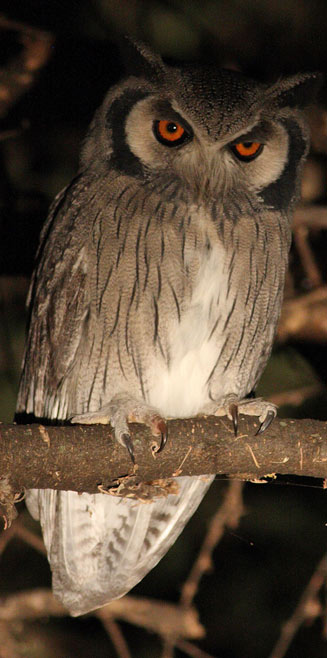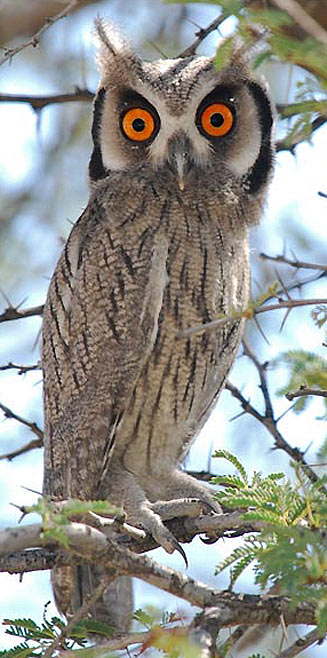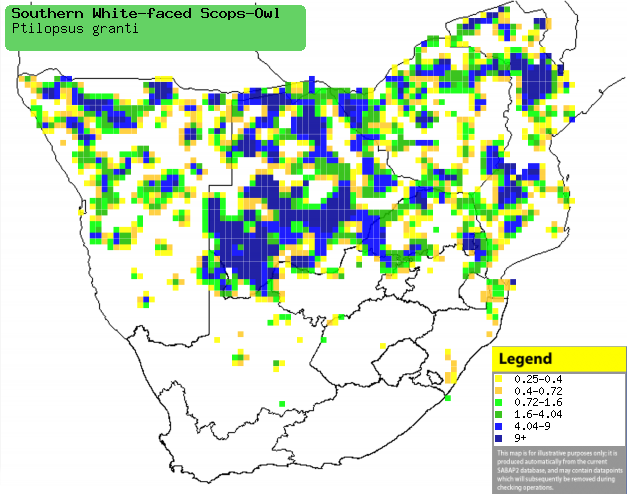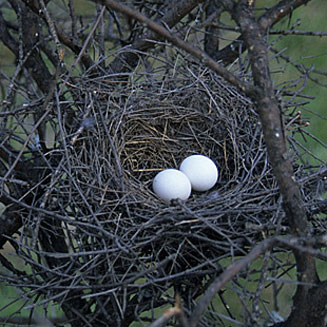|
Ptilopsis granti (Southern
white-faced scops-owl, White-faced owl)
[= Otus leucotis]
Witwanguil [Afrikaans]; uMandubulu [Zulu]; Kakuru (also applied
to other owl species) [Kwangali]; Zizi (generic name for owl) [Shona];
Kurkurtavoni [Tsonga]; Lerubisana (applied to a number of other owl species)
[Tswana]; Witwangdwergooruil [Dutch]; Petit-duc de Grant [French];
Weißgesicht-ohreule [German]; Mocho-de-faces-brancas [Portuguese]
Life
> Eukaryotes >
Opisthokonta
> Metazoa (animals) >
Bilateria >
Deuterostomia > Chordata >
Craniata > Vertebrata (vertebrates) > Gnathostomata (jawed
vertebrates) > Teleostomi (teleost fish) > Osteichthyes (bony fish) > Class:
Sarcopterygii (lobe-finned
fish) > Stegocephalia (terrestrial
vertebrates) > Tetrapoda
(four-legged vertebrates) > Reptiliomorpha > Amniota >
Reptilia (reptiles) >
Romeriida > Diapsida > Archosauromorpha > Archosauria >
Dinosauria
(dinosaurs) > Saurischia > Theropoda (bipedal predatory dinosaurs) >
Coelurosauria > Maniraptora > Aves
(birds) >
Order: Strigiformes
> Family: Strigidae
 |
 |
| Southern white-faced scops-owl,
Kgalagadi National Park, South Africa. [photo
Johan van
Rensburg ©] |
Southern white-faced scops-owl.
[photo
Callie de Wet ©] |
The Southern white-faced scops-owl is common in many parts of
southern Africa, living in a wide variety of habitats, ranging from Miombo
woodland to low thorn scrub. It mostly eats small mammals, with birds and
invertebrates making up the remainder of its diet. It uses stick nests made
by other birds as nesting sites, sometimes evicting falcons out of their nests,
before they have even finished laying their eggs. It lays 2-4 eggs, which are
incubated mainly by the female, with the male doing most of the hunting. The
chicks leave the nest at 28 days old for the surrounding bush, and are dependent
on their parents for at least 2 weeks more before leaving completely.
Distribution and habitat
Occurs in sub-Equatorial Africa, from southern DRC and
Tanzania to Zambia, Angola, Malawi and southern Africa. Within southern Africa
it is locally common in Namibia, Botswana, Zimbabwe, Mozambique and
north-eastern South Africa, occupying a wide variety of habitats. It is most
common in areas with scattered thorn trees and scarce patches of ground cover,
but it also occurs in suburban gardens, grassland and semi-desert scrub,
typically near watercourses or alien tree stands.
|
 |
|
Distribution of Southern white-faced scops-owl in southern Africa,
based on statistical smoothing of the records from first SA Bird Atlas
Project (©
Animal Demography unit, University of
Cape Town; smoothing by Birgit Erni and Francesca Little). Colours range
from dark blue (most common) through to yellow (least common).
See here for the latest distribution
from the SABAP2. |
Food
It hunts by flying from perch to perch, trying to locate prey. Once prey is spotted,
it descends to the ground to pluck the animal up with its talons. In one study
on the proportion of food items in its diet, it ate 81% small mammals, 14%
insects and 4% birds. The following species have been recorded in its diet:
Breeding
- It usually nests in stick nests made by other
birds, sometimes evicting raptors (eg.
Shikra,
Gabar goshawk,
Ovambo sparrowhawk) before they have even laid all
their eggs! It also nests in natural cavities in trees.
 |
|
|
Southern white-faced owl nest, Sericea
farm, South Africa. [photo Warwick Tarboton ©] |
|
- Egg-laying season is mainly from August to November, exceptionally in February and May.
- It lays 2-4 eggs, which are incubated mainly by the female for 30 days,
while the male does most
of the hunting.
- The chicks are are fed only by the male for about two weeks, after which
both sexes do the hunting. The brood leave the nest for the surrounding bush
when they are 28 days old, and can fly 2-5 days later. They are dependent on
their parents for at least two weeks after leaving the nest.
Threats
Not threatened.
References
-
Hockey PAR, Dean WRJ and Ryan PG (eds) 2005. Roberts
- Birds of southern Africa, VIIth ed. The Trustees of the John Voelcker
Bird Book Fund, Cape Town.
|
